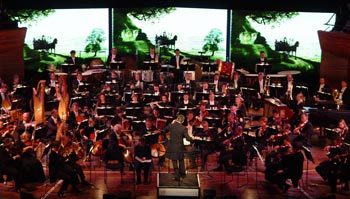This weekend, The Fellowship of the Ring in Concert came to Radio City (event review here). On Sunday, the Angel Orensantz Foundation hosted a Behind the Music event, featuring Tolkien linguist David Salo, documentarian Elizabeth Cotnoir, journalist Doug Adams, and Howard Shore himself.
Whether you were looking for a Lord of the Rings fan event, a composition lecture, a language major’s best revenge, or a breakdown of the creative process, it was pretty awesome.
David Salo is author of A Gateway to Sindarin: A Grammar of an Elvish language from J.R.R. Tolkien’s Lord of the Rings and an accomplished linguist (when asked what languages he read or spoke, he counted on two hands and never even got to Tocharian, his professional interest as listed in Wikipedia). He gave a wryly funny talk about how he offered his services and was sent a test request to translate the inscription on Sting. When the producers questioned how he knew it was right, he sent a 25-page proof and got the job. (Basically, David Salo is the shit. Also, I want to read that proof.)
After he had the entire audience in the palm of his hand, he settled into the dirty details of how to translate—and often, invent—lyrics in Tolkein’s many languages. He laid out the reasoning behind assigning suitable languages to the lyrics (archaic Quenya for Elvish lyrics with larger scope, Sindarin for more immediate emotional concerns), the problems of creating a workable Dwarvish language when Tolkien had provided minimum text (he looked at Old German and Hebrew to get the phonetics he wanted), and the logistics of getting it all done when he routinely got emails asking for entire songs or conversations with six-hour turnarounds.
Next up was Elizabeth Cotnoir “Journey’s End,” a slice-of-life single-camera documentary about Howard Shore’s process. There were hints of the egoless auteur to come when he talked about each score only in terms of the pencil leads used (six each for FOTR and TT, seven for ROTK) and marveled over the china cups in his London hotel. (There were also clips of Annie Lennox recording demos of “Use Well the Days,” an early contender for the Return of the King closing theme that was unfortunately shelved for the more upbeat “Into the West.” Fact: Annie Lennox has pipes.)
Then it was the main event, when journalist Doug Adams and Shore himself took the stage. Shore is a soft-spoken, matter-of-fact artist. When asked about his inspiration for Lord of the Rings, he laid out how he spoke with director Peter Jackson to understand the intended tone for the trilogy, went home and laid out the major themes he would need, listened to opera, researched 19th-century choral pieces, and sourced unusual instruments.
The actual composing process was described as “laying track down in front of an oncoming train,” which is the kind of creative metaphor I can really get behind. He named the destruction of the ring the most daunting cue, but pointed out that after four years of work he was too worn down to worry, and the night before they had to record that scene he sat down and wrote it, because it was due. (Seriously, best creative process ever.)
However, his craftsmanship is evident even though his ego isn’t; he reworked the initial score to fit the running time of the theatrical releases, reworked them again for the Complete Recordings, reworked them again for the Symphony, and had made some changes to the Concert itself earlier in the week. His knowledge of composition is immense (he’s been writing music since he was ten), and it was clear listening to him that this score was the result of a master at work on a masterpiece. The subtle things yielded the most interesting results; he mentioned that after writing a main theme for each race or setting, he never went back to the original theme to listen, preferring to pull from memory so that the recurring theme would be similar but not identical, building as part of the overall score as the movies progressed and the overall tone changed.
Shore and Adams will be stopping in several other cities for Q&As promoting Adams’s upcoming book The Music of the Lord of the Rings Films. You can follow the schedule on the book’s blog, and if he’s going to be in your town I highly recommend stopping by even if you’re not a Lord of the Rings fan; Shore is an artist well worth listening to, no matter what your art of choice.
Genevieve really, really wants to read that proof about the inscription on Sting. Instead, she’ll speculate wildly about it on her blog.










